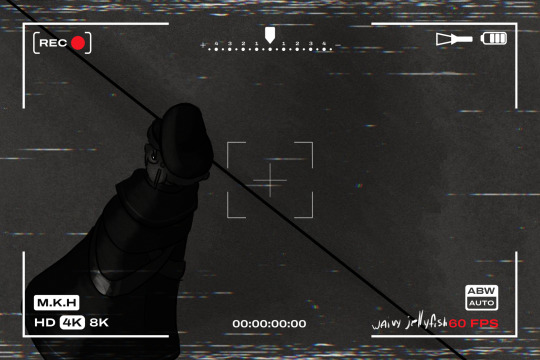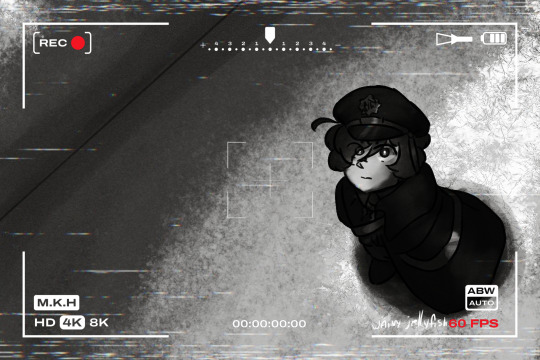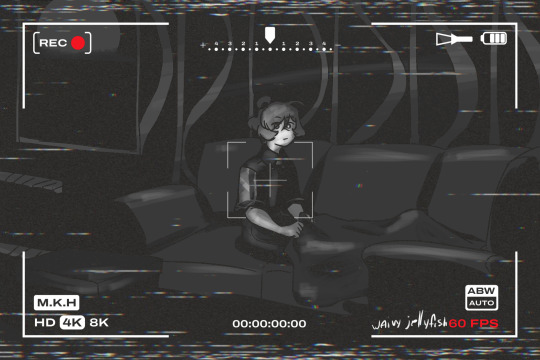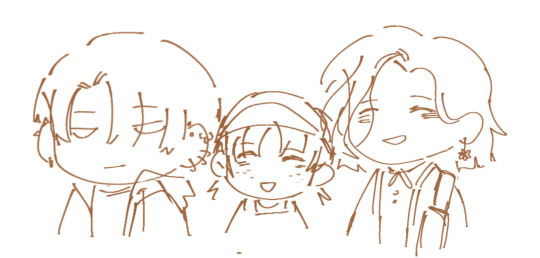Text
OMG THEY ALL BELIEVE IN 000803 SIBLINGS AND KAZUI AS THE FATHER IM CRYING AND CAKCLING DJSNQJAMAMWMWM
context: anni stream
16 notes
·
View notes
Text
What?!
Just went onto the livechat I regret everything people are so horrible there
10 notes
·
View notes
Text
Hold up what happened?
Just went onto the livechat I regret everything people are so horrible there
10 notes
·
View notes
Text


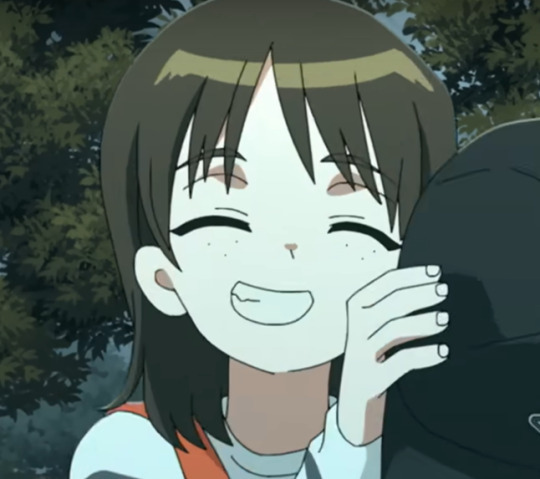





i think i Am going to throw up. Everywhere ❤️
bonus: LUCKY HAS BOTH THEIR GENES 🔥🔥🔥[STARTS SOBBING VIOLENTLY]
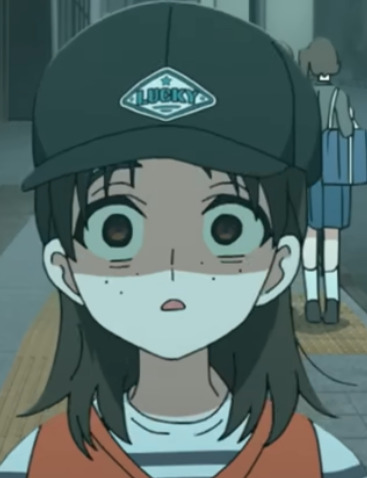

22 notes
·
View notes
Text








i think i Am going to throw up. Everywhere ❤️
bonus: LUCKY HAS BOTH THEIR GENES 🔥🔥🔥[STARTS SOBBING VIOLENTLY]


22 notes
·
View notes
Text
found an old undercover analysis, might as well share it. i wont just let it rot in my notes.
undercover lyric analysis thing
i will only be covering about the lyrics that are sort of es centered. took the lyrics from the official en yt tl.
Ravaging, brawling
Losers please exit left
Even with accusations full of faults and mistakes
You will for sure, with a smile for sure
Be pleased and satisfied
Take, grab, steal
'Dissect the thoughts of "why"
Looking for mistake overtime
To know someone, to bind them in their 'EGO'
Can you really judge them?
The fine line between "Hate" and "OK"
Shouldn't you look beyond your EGO, before it all ends?
After knowing all i wonder
Can you really say INNOCENT?
Decievings, "UNDER", ineraseable
'Ravaging, brawling'
ravaging means causing massive damage and brawling means fighting roughly but the meaning in slang can be a loud disagreement. we are causing massive damage with the verdicts we give out, and we are loudly disagreeing with eachother.
'Losers please exit left'
exiting left can maybe also be represented as swiping left. swiping left means rejecting somebody, but in this case, rejecting their ideals and beliefs. (idk just thought of the dating app type)
'Even with accusations full of faults and mistakes-'
they're literally calling out a part of the community. some people just vote without analyzing the crime correctly, basically 'accusations full of faults and mistakes'.
'-You will for sure, with a smile for sure. Be pleased and satisfied'
in this part, the mv was showing each of the prisoners 1 by 1 smiling/grinning (?) but they were all mirroring es (looking at the same angle). why were all of them mirroring es? maybe its because es is supposed to be them embodiment of sin (their sins), i mean, undercover was literally a brief explanation of each of the prisoners mindset on their sin.
'Take, grab, steal. Dissect the thoughts of 'why''
i have a silly theory for this, but like, hear me out !!!
1. take = taking something/memories with consent (take as super-ego)
explanation : the super ego strives for moral perfection. the primary action of the superego is to suppress entirely any urges or desires of the id that are considered wrong or socially unacceptable, thus asking if said person consents to have their item taken.
2. grab = grabbing is taking something or with the milgram system, taking memories roughly/snatching something or can mean to cause a reaction in; affect (snatching the memories and grasping to a rough idea) (grab as id)
explanation : the id is a set of uncoordinated instincitual behaviors/desires, thus taking/grabbing memories without thinking about the consequences.
3. steal = steal is something/stealing memories, taking something/memories without permission or legal right and without intending to return it. (steal as ego)
explanation : the ego is a sense of self-esteem and self-importance that is balanced and grounded in reality. it allows a person to have confidence in their abilities and to assert themselves when necessary, but it does not become inflated or overbearing. the ego also is pushing us to confront or overcome our fears. many people are scared to steal so it would make sense that ego id steal.
sure, you can say take grab steal is just the same thing but im here to overanalyze stuff okay.
'dissect the thoughts of 'why' is pretty self explanatory.
'Looking for mistake overtime. To know someone, to bind them in their 'EGO''
looking for mistake overtime is self explanatory, each trial, new mv, you'll see more of the mistakes that has been done by the prisoners. binding someone in their ego, the ego is usually represented as self-worth/self-importance of a person, we are binding them in self-importance with our judgement. we are determining if their worthless (non-forgiveable/guilty) or important (forgiveable/innocent).
'Can you really judge them?'
loud correct buzzer. who gave us the right to judge anyways? we didn't do anything to deserve this. there really isn't a correct way to judge them, if we vote according to law, almost all of them would be guilty, if we vote by feelings it could be biased. everyone has different beliefs which makes it hard to determine who's right and who's wrong.
'The fine line between "Hate" and "OK". Shouldn't you look beyond your EGO, before it all ends?''
hate can be interpreted as morally black and OK is morally white. what's between them? morally grey, almost all of the prisoners are morally grey characters.
looking beyond our ego is basically voting without any bias towards the prisoners, basically beyond our ego. we have to vote correctly without any bias before it all ends because you can't reverse it anymore once it's done.
'After knowing all i wonder. Can you really say INNOCENT?'
wehwhehehehehwehehehebsxbrjficj... i think it implies that somewhere, sometime when milgram ends, according to the laws, most of them are going to jail, 'can you really say innocent?' or, when each trial progresses, more parts/information of their crime will be shown, and sometimes, it slowly become more unforgivable.
'Deceivings, "UNDER", ineraseable'
decievings can be interpreted into the story as 'deceivings of a sinner' type of thing, INMF can be used as reference (sorry muu). 'under' is probably just referencing the title "undercover". if you compile the ideas together, it just becomes deceivings undercover that are ineraseable?? i'm not to sure what to come up with this lyric. if you have an explanation, do tell.
probably alot of mistakes because this is old lmao
8 notes
·
View notes
Text
12th Prisoner in Milgram?
the key thing this theory is leaning on is the concept of the panopticon being 12 sectioned. whether the 12th section is a walkway or a cell doesn't matter for this theory, just that it exists.

10 sections is what you'd assume it to be considering the current canon number of prisoners. iirc there's eleven cells, though, with prisoner 11 implied to be es. my proposed theory is a metaphorical 12th prisoner, to round out the panopticon, and complete a clock face.
milgram seems to have a lot of links to time, and the passing of such, along with almost the loss or absence of time also being a factor. es with their amnesia, how the prisoners were presumably brought in moments after they committed / realized they committed murder (in what ever form it was), how there's an unspecified amount of time in between trials / es being awake.
the clock face and motif could be a natural progression to this theme. 11 confirmed prisoners (as of deep cover, kotoko calling es 011) could relate to the idiom of the 11th hour, a moment in time where it's the last possible moment or almost too late. it's sometimes used in horror or thriller narratives to pin point the moment just before everything goes wrong. having 11 prisoners on a clock face could be a really interesting way of implying guilt, or perhaps relating to how the prisoners were taken just after everything went wrong.
this leads me to the matter of the 12th section. for a clock to be complete, the 12th hour is necessary, even if time were to stop at the 11th hour. what's necessary to Milgram, even though its not explicitly shown? the audience.
the audience has been mentioned in passing, of course, as the voices the prisoners hear and as one of the driving forces behind es, but apart from mikoto saying how he thought milgram was a reality tv show, there's no acknowledgment of watching. of something outside of es or jackalope influencing the progression of milgram.
there's already been a slight commentary on the concept of watching and judging with fuuta, muu, and now kotoko as of Yonah. theres plenty of theories comparing those three to the audience, fuuta relating to the part of judging without fully understanding, muu specifically with her t2 song saying in the official English lyrics "I'm doing this just because I'm bored, we're just the same.", and kotoko with her strong belief in what she believes is true justice. there's more, of course, but those are the key points i remember.
with the commentary on the nature of judging that milgram already makes, it wouldn't be too far to assume that the audience has a bigger role than we already have. we already choose innocent or guilty, along with influencing the reasoning and contributing to the voices the prisoners hear.
es has been revealed to be their own character, with their own backstory and motives, so where would that leave us if es was supposed to be an audience insert? the milgram project is all about how the choices we make have consequences, along with the main theme of the prisoner's crimes.
i believe the 12th section has been reserved for us, the viewers. we're playing the role of judge, jury, and executioner in the same way we criticize kotoko for doing. it wouldn't surpirse me if at the end of the project, after the final verdicts for the prisoners, there's an extra set of votes. one for es, and one for us.
es is the audience mirror, and all of the prisoners have been grouped as a pair. if es is prisoner 011, the one they'd be grouped with is prisoner 012. you could argue es is a parallel to every prisoner in some way, and i'd agree, but that could also go for every character pairing possible. jackalope could also be es's duo pairing, but it feels unlikely as he's never been referenced as a prisoner, even slightly. we, on the other hand, would fit as es's duo due to the concept of the general audience having no specific gender, keeping the male and female prisoner count the same. almost opposite to es's non gender, we as the audience could technically be every gender, keeping the theme of the duos having "opposing" genders.
tldr; the audience is the 12th prisoner, being es's parallel for the prisoner duos.
feel free to add or object to this, its just an idea i've had sitting in my head for a while :]
68 notes
·
View notes
Text
Mentions of tumors, drugs
In the ending of Deep Cover, there's a gradual change from dull colors to bright colors.


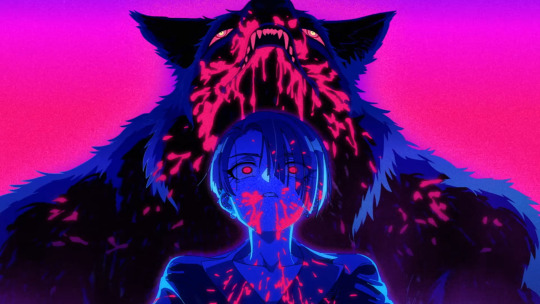
This makes me think of both bioluminescence & chemiluminescence; some other things as well, but looking at it as a response to everything that's happened/will happen around Kotoko, I want to focus on parallels to those forms of light & energy. We've seen this in HARROW as well.
Admittedly, I haven't touched biochemistry in detail in a while, so if anything is mistaken, I'd like to know.

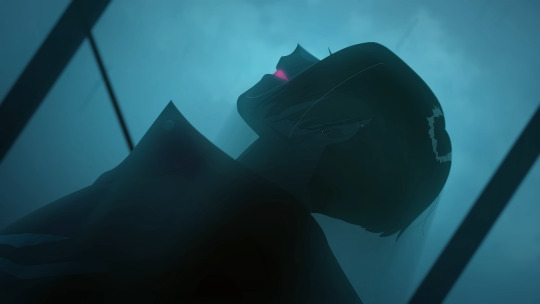
Starting with bioluminescence, usually caused by symbiosis (we'll get to that in a moment, but if you know, you know). Bioluminescence is effective for offense & defense—attracting familiars, warning predators, & mimicking other species.
Mimicry seems to be a theme in Deep Cover: from the young girl wanting to look like Kotoko, to Kotoko seeing herself as another warden, or at least with the clothes to match. It's a type of symbiosis, actually. The close interaction of those from different species. Like a human & a wolf, or a victim & their savior.
While bioluminescence is typically associated with marine life, there's also luminescent bacteria & bioluminescent imaging—which can be used to assess tumors, for example. However, regarding BLI, one of its disadvantages is limited depth.
Onto chemiluminescence, light as a result of a chemical reaction. In said reaction, there's a rise of energy that must descend to release light. Take Kotoko's grin in HARROW, & then Kotoko's conflicted expression at the end of Deep Cover. Rise of energy, then...?


It just makes me think of how feelings are associated with chemical reactions as well. Chemiluminescence is also used in forensics & to assess certain impurities.
76 notes
·
View notes
Text


No one understands how I feel about this moment and the fact that both Kazui and Hinako's face is divided into two parts, where each part expresses a different, opposite emotion to the other.

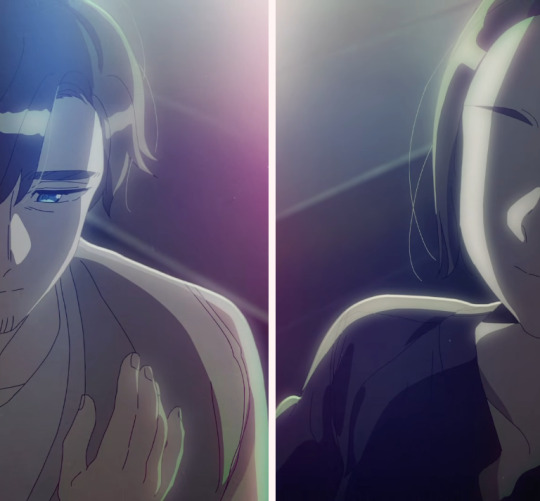
The parts of their faces that look at each other are different. A smile and its absence. If you put them side by side, then both have the same half of their face smiling while the other half is not smiling.
It's such a small detail, but I'm just crazy about it. PLEASE...
More ramblings under the cut (i'm sowwy)
I generally love to think that they are opposites in most things. And the way they are posed in this frame just drives me crazy.
He's smiling, she's not. She's smiling, he's not. But at the same time if they stand in the same direction, both will smile the same way and not.
I love to think that while Kazui is lying, Hinako is sincere and telling the truth. While Kazui grew up with a dog and was raised like that, he associates himself more with cats, while Hinako grew up with a cat in the house, but loves dogs more. (this is already my personal headcanon on Hinako's personality. That's how I see her. don't take it seriously if anything)
It's just.. just..... I like to think about the contrasts between them. That their personalities are contrasting, their emotions are contrasting, their feelings are contrasting. The green and red in the color circle are opposite each other. (if believe that Kazui is indicated in green in the MVs, and not someone else. And the scenes with Hinako's fall and death are accompanied by a red object)
At the same time, it's hard for both of them. Both are under public pressure. Both are trying to do something about it.
Similar and different.
When people say that "opposites attract," but this time it didn't happen. Just not in terms of a romantic relationship.
138 notes
·
View notes
Text
I think my most meta milgram theory is that all the prisoners relate to social issues in Japan (this was brought up by my friend but they don't have tumblr so I'm gonna post it here)
Haruka- ableism, specifically against learning disabilities. Haruka's story is all about how he was born "wrong" and how his mother didn't want him
Yuno- the abortion debate
Fuuta- online harassment and cancel culture
Muu- bullying, and how in social structures someone always has to push someone else down to be on top (the whole hourglass metaphor)
Shidou- curroption in the organ donation system, and how brain death is viewed in Japan
Mahiru- societal expectations of women, and the pressure to marry
Kazui- okay so since his crime is vague rn, either A. Cheating or if gay kazui theory is correct B. Lgbtq issues, could also be japan and it's issues with intimacy and how his wife felt unloved but he didn't realize
Amane- Japan and its history with cults
Mikoto- ableism against the mentally ill, and the "just endure it" view of mental illness in Japan which makes alot of people reluctant to reach for mental health help. It's probably why Mikoto seems to not realize he had DID or OSDD
Kotoko- curroption in the legal system, and how crime against women and children are often ignored by the police
1K notes
·
View notes
Text
Kotoko's Connection with the Fairy Tale of Red Riding Hood
So THIS WAS SUPPOSED TO BE A JOKE POST, but I kept looking into it, and now here's a full blown analysis instead lol. I realized that Kotoko has many allusions to the story of Red Riding Hood besides the wolves and her signature red jacket. The themes of familial love, protection, and deception all seem to be reflected in Kotoko's actions and what we know of her past and personal life so far. So this post will detail more of the connections between her and this tale, as well as theorize on certain parts on what her story might reveal in the future!
MAJOR THANKS to my English major himejoshi librarian bunny mutual @lillyviarabbit for proof reading this so that my writing doesn't sound clunky af 🙏
A Quick Aside: The Other Side of this Tale
So...there's another side to the original tale of Red Riding Hood, one that deals with much heavier themes on what the story as a whole is supposed to symbolize. And I wanted to preface this by saying that I will not address those aspects in this little analysis. This is mainly because I just don't think we have enough evidence or hints as of now from Kotoko's past that suggests these parts from the Red Riding Hood story are also in her story. I did not want to speculate on these parts either because I wanted to treat them with respect, rather than simply speculate that they have to do with a fictional character's past when we don't even have any evidence to theorize that they do. So this post will only touch upon the more well known parts of the story instead!
Also I won't be talking about Jacques Roulet and his weird ass story because none of it makes sense to me with how it's related to Kotoko, so I will leave that to someone with a bigger brain to analyze that 💀
Allusions to Red Riding Hood Herself:
One of the major similarities between Kotoko and Red Riding Hood is — well — the red hooded jacket!

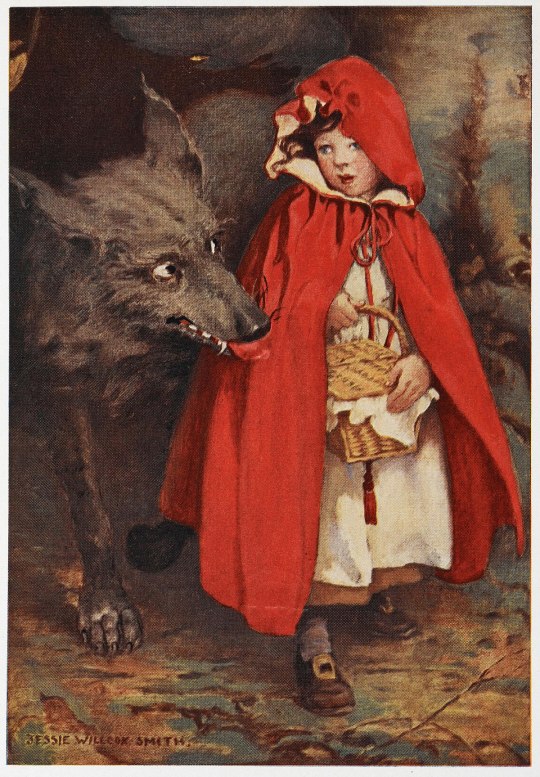
This jacket is the most recognizable part of the fairy tale, and it clearly sticks out in Kotoko's wardrobe as the outfit she wears while she's in her forest world, notably with the wolves she's running with in HARROW.

Appearance wise, Kotoko also seems to fit the bill for how Red has been portrayed throughout various iterations of the story over time.
Red's appearance generally describes a girl with short black hair and a bob that reaches down to be exact.
"Another difference lies in the fact that, in addition to [her hair] being black, Little Red Riding Hood’s hair is generally short, reaching to her chin at most, with a charming bob that frames her face."

The signature hood is also noted, with Kotoko's prisoner uniform being the only one to notably have a hood on it.
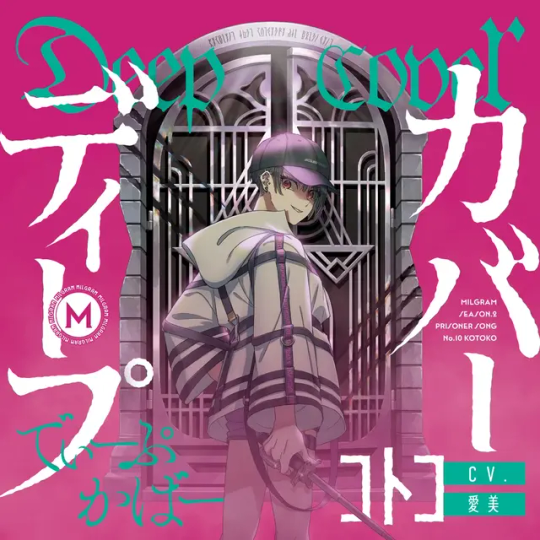

"It becomes a powerful indicator of sense. History shows that an object that goes on a woman’s or girl’s head has always been ambivalent, not to say ambiguous. It covers, it conceals, it protects, but it also alludes, adorns and attracts."
Not only does Kotoko's hood uniform reflect her similarity with Red Riding Hood, it also highlights Kotoko's tendency to protect/conceal all the aspects of herself she does not want to reveal to anyone else.

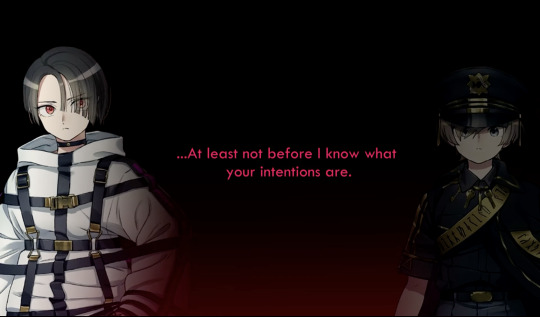
It's clear that Kotoko doesn't trust anyone else in the prison, wanting to conceal as much stuff about her as possible so she can analyze their behavior and how much they change following the time between trial 1 and trial 2. This secretive nature, interpreted by her actions and the hood she wears as a way for Kotoko to protect herself and her fragile self-worth, is also highlighted in Streaming Heart's lyrics.
"Though I seem to say many things, please try and seek out the real me.
In the space between truth and lies, hidden away so well."
The Grandmother:
Another major fact that gets overlooked is how Kotoko offhandedly mentions in her family structure that she has a grandmother. As a lot of us already know, the main plot of Little Red Riding Hood is that the girl delivers foods to her grandmother, who is sick and lives in a house in the woods. This detail from her interrogation is rather...specific, given that she doesn't even mention having a grandfather, just a grandmother along with her parents and older brother.

One additional piece of evidence that connects to this is the symbolism of her birthday flower, Monstera Deliciosa!

In many Asian cultures, this plant can also symbolize a respect and honoring of the elderly. Interesting, considering that this is the plant Yamanaka picked out for Kotoko.

While we don't exactly know the details between Kotoko and the relationship she has with her grandmother, her birthday flower seems to hint that she has some kind of respect for her, or at least they are most likely on good terms with each other.
"Once upon a time there lived in a certain village a little country girl, the prettiest creature who was ever seen. Her mother was excessively fond of her; and her grandmother doted on her still more. This good woman had a little red riding hood made for her. It suited the girl so extremely well that everybody called
her Little Red Riding Hood."
And that is why I wonder: did something happen to Kotoko's grandmother that made her realize how flawed and unfair justice can really be? Well, we know that in the story, the wolf disguises himself as Red's grandmother to try and trick her. But why litter Kotoko with all this wolf symbolism (besides the dog/tool dehumanization she's associated with) if she's supposed to allude to the character of Red Riding Hood?
The Wolf:
There is a major difference when it comes to the Tale of Red Riding Hood and Kotoko’s MV symbolism, which is the wolf’s role in each of their stories.
For Red, the wolf is the enemy. The wolf is one who tricks her from the very beginning, and the one who tries to eat her and her grandmother.
"Grandmother, what big arms you have!"
"All the better to hug you with, my dear."
"Grandmother, what big legs you have!"
"All the better to run with, my child."
"Grandmother, what big ears you have!"
"All the better to hear with, my child."
"Grandmother, what big eyes you have!"
"All the better to see with, my child."
"Grandmother, what big teeth you have got!"
"All the better to eat you up with."
But Kotoko…she’s with the wolf. The wolf is instead her companion it seems, the one who runs and sits beside her when she’s doing her vigilante stuff.
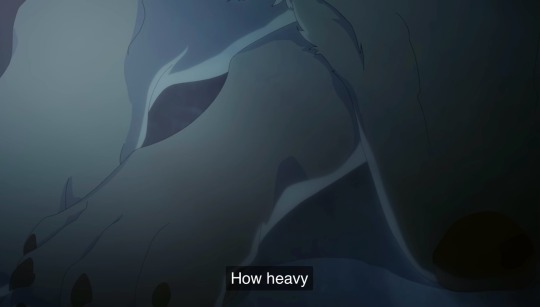

And more importantly, the wolf seems like the one to be enabling her, helping her continue with rescuing the little girl and beating up the child kidnapper. It is the one thing by her side that encourages her to bare her fangs and protect the weak.

People have speculated that this wolf represents a person in Kotoko's life, a vigilante partner she used to have? Her older brother perhaps? Who knows really, but I think we can all agree that this wolf is a person who has influenced Kotoko a lot. It is the one thing that pushes her continue with this, to continue with the cycle of cruelty and violence in her act of handing out her own form of justice. And that brings me to Kotoko's jacket again.
The Red/Pink Jacket:
I want to address the difference between Kotoko's jacket in her forest world, as opposed to it in the real world. In the forest world, we see that the jacket is more of a hot pinkish color.
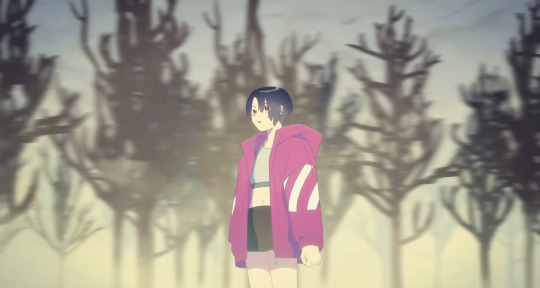
I'm not sure if this is fully because of the lighting, but the color difference for the jacket is very notable if you compare them side by side. In the real world, the jacket is clearly more red than pink:

So why make this jacket two be two different colors in two different places? Well, I'd like to theorize that the answer has to do with this girl that appears for a brief few seconds in HARROW, in the flashback sequence while Kotoko is beating up the child kidnapper dude.
Or as I like to call her: PINK SHIRT GIRL ✨

One final thing I wanted to talk about is how this girl relates to Kotoko, the different colors for her same jacket in the MV, and the sole reason why I think she wears a pink shirt. A lot of people have speculated that this girl is a younger version of Kotoko, possibly back when she was a child. Pink for Kotoko seems to emphasize her ideals at their most pure level.
When Kotoko is wearing her jacket when its pink, she's in her forest world that emphasizes Kotoko's her purpose in protecting the weak. She's emotional there, she falters, worn out by the running and desperate to continue on going. There is nothing shown in those scenes that shows her childlike ideals being tainted, yet.
But when Kotoko alludes to her self-hatred and the wolf urges her to go on with the attack, HARROW switches back to the real world where the jacket is red. We Kotoko smile after she presumably kills the child kidnapper guy as she declares that she wants to be "drowning in the knowledge that [she] is right", and thus, this seems like we the audience realize this is the moment when Kotoko's ideals begin to become more distorted than how they were presented in the forest world.
We see that she finally gains a satisfaction that everything that she did wasn't for completely nothing, and that she now has the purpose that makes her existence useful. While she does want to protect the weak and give out justice, it is not entirely motivated by altruism, as HARROW points out. When Kotoko's pink jacket becomes red, it seems to signify how her pure, child-like ideals become tainted and much more flawed compared to them initially.
This, along with Kotoko having the wolf as her companion, all seem to point at just how much Kotoko herself has become the very monsters she wanted to destroy. The child-like pink has now become a red stained with blood, or rather a shade of magenta. A mix of red and pink that highlights Kotoko's immature and child-like view of a black and white world, while also noting that Kotoko is not the innocent Little Red Riding Hood she once was anymore—

She is the wolf. She is a Red Riding Hood who has been led on by the wolf's ideals, the prey that has been ensnared and eaten by the wolf at the end of the original Charles Perrault story.

She is the wolf, the monster now.

She is now the sinner she hates so much.
Sources:
https://journals.openedition.org/strenae/6423 This one is the Red Riding Hood clothing analysis!
https://core.ecu.edu/parillek/littleredcinder.pdf "Little Red Riding Hood" Charles Perrault version
https://medium.com/@monsterahelpful/the-symbolism-and-history-behind-the-monstera-leaf-unveiling-its-meaning-11ba828837c2 Monstera Deliciosa symbolism!
https://twitter.com/pug_maniac/status/1735912110423732687 Yamanaka's tweet for Kotoko's birthday flower!
https://en.wikipedia.org/wiki/Little_Red_Riding_Hood The Wikipedia page for Little Red Riding Hood! This also contains the heavier themes I was talking about in the beginning, so if you want to find out more, they have a whole section about it here. Trigger Warnings for sexual assault and rape for this Wikipedia page.
https://youtu.be/VrAW8zyoEiY?si=a3p4nb8B1TTza-x_ Translation video for Kotoko's first voice drama, Task.
https://youtu.be/_gTTtS0Fvxk?si=Y1Zwu3XOI_nRHgex HARROW MV
78 notes
·
View notes
Text
I know the order of the songs in TeddyLoid’s JAILBREAK MEGA Mix don’t mean anything but I thought it’s pretty neat anyway so here’s my thoughts about it:
(*Yes, I’m reaching with these although imo if you overthink enough, you can relate all prisoners with each other one way or another but that’s for another day.)
Keep reading
30 notes
·
View notes
Text
This has been on my mind since Kazui’s VD came out.
Despite Es being presented as a blank slate at the start, we all know that Es obviously DOES have their own traits.
And I found this specific line from Kazui’s t2 VD really interesting:
Es: It's a personal dislike of mine. People who act based on their sexual urges like that, that is.
Kazui: It's personal?
Es: Yeah. That's right.
Es emphasizes that it’s a personal dislike.
And because Es’ theories are basically ours, they assumed that Kazui cheated on his wife.
Es shows clear distaste for the crime throughout the VD, as they do for all the prisoners. However, I would argue that they had much more distaste for Kazui than they did for the other prisoners’ crimes so far, even though they forgave Kazui. (They state that they forgave him purely because of a lack of information)
Here are some interesting direct quotes:
Es: Marriage is something that both partners want equally, isn't it? It's something you can't do if only one person wants it. Deciding to treat it as a punishment all on your own... You're making a mockery out of it.
Es: Hah? Stop staring at me so openly. It's disgusting.
Kazui: ...
Es: ...! (punches him) (clattering)
Es: (sighs) Now I feel better.
Kazui: - Ow...! What are you doing all of a sudden..?!
Es: It was an instinctive reaction. Don't take it personally.
Es: In short - between love and hate, [I would say] I hate you. Remember that.
It really does seem like a personal thing rather than what we, the audience, think.
The VD ends up rather emotional though because of Es empathizing with Kazui more after he broke down. However, before then, Es was openly hostile.
You probably already see what I’m getting at.
Es has a pre-existing bias against these things that possibly relate to their past.
And an “instinctive reaction”? Interesting.
Es also has always hated when the older prisoners looked down on his for his age. Not to mention, this is also the 2nd time Es has slapped Kazui.
Es has so far slapped, punched or kicked a handful of the prisoners multiple times throughout the VDs. Though, it’s been exclusively the dudes. The only dude who hasn’t been violently hit by Es is Fuuta, funnily enough. Off topic but I find Es and Fuuta’s relationship during t1 super funny like Es did not take Fuuta seriously at all😭
Okay, I know everything I’ve shown here is alluding to something possibly very dark about Es’ past but I would like to remind you to take what I’m saying with a grain of salt. I just compiled some info about the VD’s I noticed, so it’s possible that I’m jumping the gun here.
In fact, I don’t think all of this is enough info about Es for me to confidently base a solid theory off of. So I’m not going to try to… yet, at least.
But I just thought this was an interesting tidbit to point out!

77 notes
·
View notes
Text
"Undercover" Makes Me Suspect Things
I went into watching "Undercover" thinking I could make a fun analysis post, and now I just have a Tumblr post with enough red string that I could make scarlet letters for all the Milgram prisoners.
Let me just address the elephant in the room: I understand that Es's "Undercover" probably just serves as a hook to get people's attention and that I am probably reading too much into this. But consider this, wouldn't it be great if I'm right? Now, right about what exactly?
Well, namely, I think Es's song is either a prophecy/warning, or it was not extracted until the three trials ended or at least after the first trial concluded because Es seems to know far more than they should about the prisoners if this song was extracted after the first day of Milgram when Es and Jackalope's voice drama took place.
Now, “Undercover” is very fast, and even at 0.25x speed, I constantly had to rewind and pause to take screenshots. A picture is worth a thousand words and holy guacamole, there were so many frames. To be honest, even if I don’t have the words for everything, I will be showing off what I found to be the most interesting.
The Song Extraction Device & the Panopticon:
First, I want to get into the Song Extraction Device (SED). We know from Jackalope’s “This is Milgram” that the SED can pull mental images from a person’s mind and turn them into a music video. Thanks to Jackalope, we also know the SED can’t pull them all in one go, hence the three trials. Jackalope also states that the verdict of a trial will affect what the SED will pull in the succeeding trial. In the opening and closing shots of "Undercover" we can see that 000 is stamped in its red button/latch.
When I rewatched the “This is Milgram” video, you can see the rooms in the Panopticon spinning on the projection board. In the first voice drama with Es and Jackalope, “Es”, Jackalope tells Es to think of the Panopticon as a clock, with the entrance being the 12 o’clock position and the prisoner rooms being the rest of the corresponding numbers. You can see the room numbers on each room. The first room moving clockwise from the entrance is 001, but the first room moving counterclockwise from the entrance is 000, not 011.
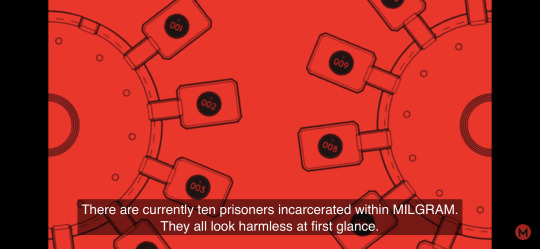

In “Es”, Es asks if there was someone in that room at the 11th o’clock position. They even note that the door looked even older than the others thanks to the rust, and it didn’t even have a lock like the others. Jackalope tells Es not to worry, and before Es can even respond, a bell rings, and Jackalope diverts the conversation by announcing that the prisoners should be waking up soon.
The normal pattern is voice drama, then musical number, but to be honest, I don't know for 100% certainty if the voice drama came before the musical number. I would assume so, but you know what they say about assuming. It would be interesting if Es, because they are different from the ten prisoners, had a musical number and then woke up to have their voice drama with Jackalope. The 000 room is very suspicious to me. It's the oldest room, and if it used to be Es's, then that is a point to the Es is the eleventh prisoner theory. My only point detracting from the Es is the eleventh prisoner theory is that Es didn't get a second song during the second trial like the ten prisoners receiving. That, and besides the amnesia, what made Es so special that Milgram inducted them into their odd prison? Did Es prevent a murder?
Bookend Frames & Chalk Es:
Let’s kick things off with the bookends. We open up on Es walking towards the SED with Jackalope following him, and then the song closes with only Jackalope in view.
Bookends are a framing device primarily used to link the beginning and end of a story in a satisfying way. The ending can be a word for word copy of the beginning, or it can be a mirror of the beginning.
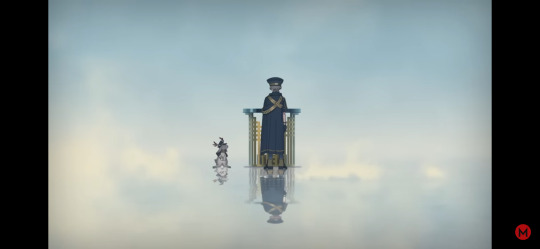
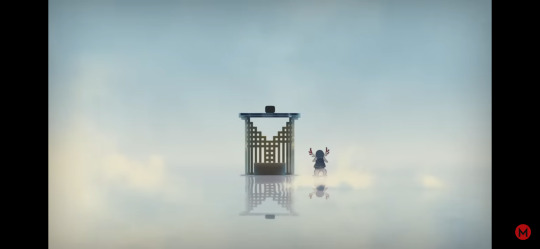
The most obvious mirror moment is the beginning shot ending on the SED opening up and the ending shot starting on the SED closing. The location of both shots are the same and the fog seems to be about the same amount and concentrated in the same area in both shots. Jackalope is on the viewer’s left at the start, facing the viewer, and then at the end, he’s on the viewer’s right with his back towards the viewer. But Es is gone.
Where is my child cop, Jackalope?
Let’s focus on the opening shot. We have Es and Jackalope entering from the viewer’s left, which is stage right. While I was trying to get a good shot of the two in the opening, I noticed that Jackalope spends a considerable amount of time in the fog compared to Es. It could just be that Es is considerably bigger than our most honorable warden, Jackalope, and that the mist is heavily concentrated on stage right. Since Es has amnesia, perhaps the fog he walks through is literal brain fog or just the intrigue of Milgram in general. Intrigue fits why Jackalope is so hidden in the beginning. It's not deep or hidden, but it is nice and straightforward.
Right before the third chorus, Es sings, “losers please exit left.” Did Es exit stage left from the frame? Did Jackalope follow him across the stage but didn’t step offstage? But here is what really skeeves me out about Es not being in the ending. The song ends after the last chorus, and once Es finished the third and final chorus, we see what looks like a chalk outline of Es. Es is not wearing their full prison guard uniform. Their hat and cape/cloak are missing.
Now, chalk Es first has their back turned to us and is watching the prisoner montage. Their silhouette is hazy at first, but it becomes more clear as the montage continues. And then they turn around. I don't know what causes Es to turn around, but they look like they are trying to figure out what caught their attention. Then, what seems to be a spotlight directly overhead turns on, blinding Es so they shut their eyes. They bring up their hand to their eyes and they open them again. Their eyes adjust, and they make something out. Whatever it is/was, it appears to have surprised or shocked Es.
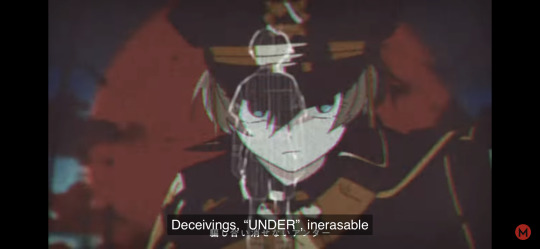
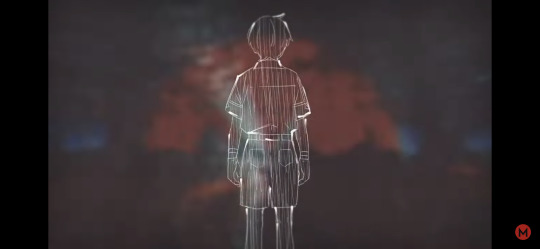

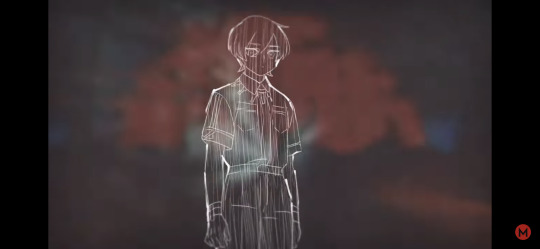
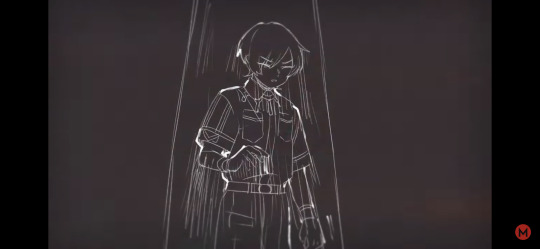


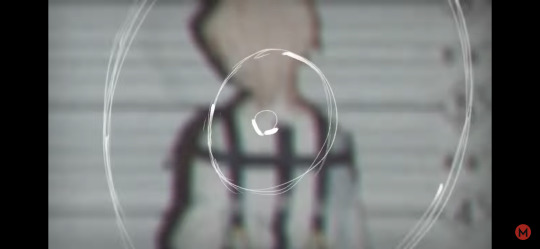
Now, Es isn't exactly stoic. They're very touchy about their role as prison warden, and they become very agitated whenever the prisoners throw them for a loop. But chalk Es doesn't lash out like Es does in the voice dramas. They may not have had the time to react, but even when Orekoto was beating the crap out of them, Es was still taunting him. Something definitely caught chalk Es off-guard. The question is what exactly is capable of rendering him silent.
I think it has to do with whoever is running Milgram. We know Es relies on social hierarchies to maintain a sense of control. They lash out when the prisoners, their social inferiors, disrupt that hierarchy and act familiar with them. I don't think Es would lash out if it was their superior in Milgram. Es can be short with Jackalope and even tease him, but they tend to take Jackalope at his word, albeit with exasperation for the not-rabbit's antics. Perhaps, it's not a superior calling for Es's attention, but something Milgram is doing to the prisoners. Something that goes against his firm belief that Milgram is all-good.
The Prisoners & the Choruses
(EDIT: WHOOPSIE DAISY. It turns out that Milgram had changed the subtitles for the third anniversary. The vibes between the lyrics quoted below and the original one are quite similar, but let me do a quick review and reblog for corrections.) While the lyrics played over the prisoners aren’t directly pulled from their respective Trial 1 songs themselves, all of them reference the titles to their respective Trial 1 songs (see bold).
I only highlighted one of Kazui's "half"s since it was not doubled like MeMe was for Mikoto.
The information presented in each two line sets is not something Es could have known before the trials began. Es can only remember their name and age. This is what got me thinking that maybe "Undercover" takes place between the first and second trials, or after all the trials had been completed. At first, I thought maybe "Undercover" took place before the three trials had even started, and this was what Milgram was erasing from Es's mind: his knowledge of what they had done. Because during the third and final chorus, we see the prisoners 'kill' Es just like how they killed their victims. Did Es learn of their crimes and had to have his memories removed to ensure a fair three trials? Or is this even the first time these prisoners have been tried through Milgram's system?
Here are the two line sets overlaid on the prisoners during their respective mugshot montage.
Haruka: “If you say INNOCENT, you’re complicit and weak / I’m so lonesome, please love me”
Yuno: “My cord is being pulled but nothing’s ever enough / Contractual desires, oh what to do”
Fuuta: “Hiding and seeking from sin / Bring it, submit, and also shut your trap”
Muu: “Clutching a broken heart / The pain’s still there, after all this time”
Shidou: “Which way will you throw down your weight / To be the deceived, or the deceiver”
Mahiru: “I don’t wanna just give / Giving and taking, this is how to be in love”
Kazui: “I just keep on dreaming / half in, half out, I’m doomed”
Amane: “The magic is in believing / There is no righteousness in broken promises”
Mikoto: “Don’t you lie about Me / Me, I’ve done nothing wrong”
Kotoko: “Dedicating my life / Harrowing, burying the thing I want erased”
During the third chorus of the song, we get a rapid sequence of frames that are supposed to clue us in to each prisoner’s murder. But what I did not notice during my previous viewings was that the expressions and the positions of the prisoners during the first chorus change to something different in the second chorus.
Haruka & Yuno:
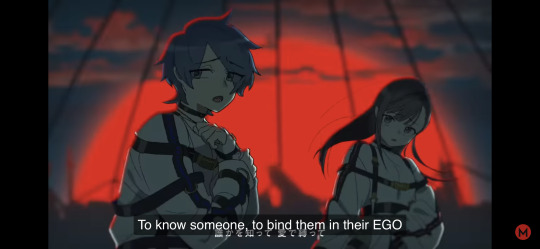
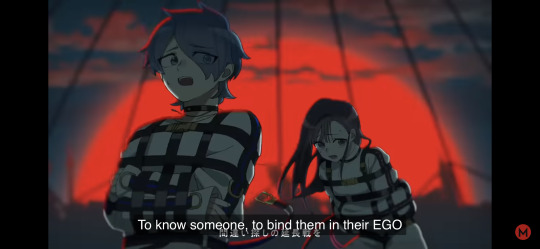
Fuuta & Mu:
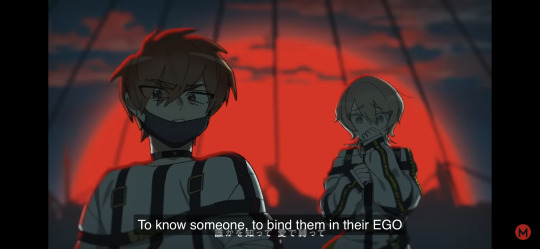
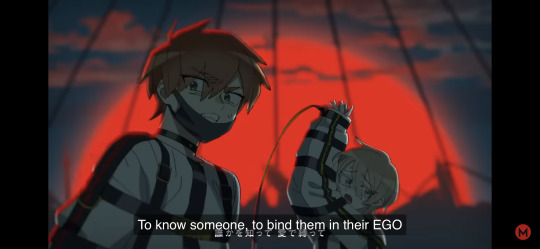
Shidou & Mahiru:
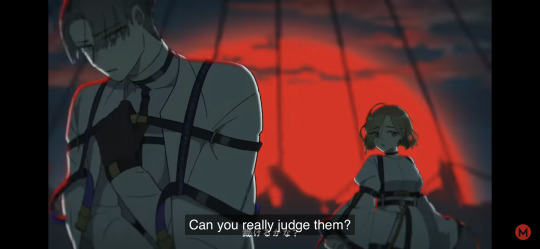
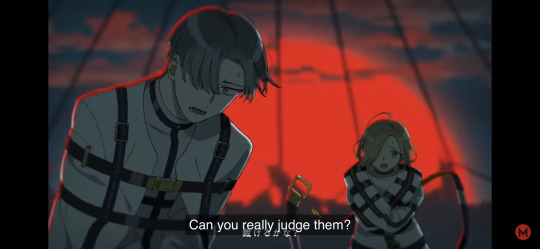
Kazui & Amane:


Mikoto & Kotoko:
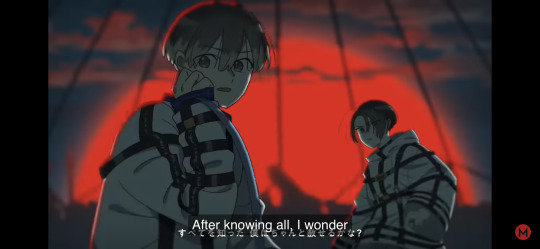
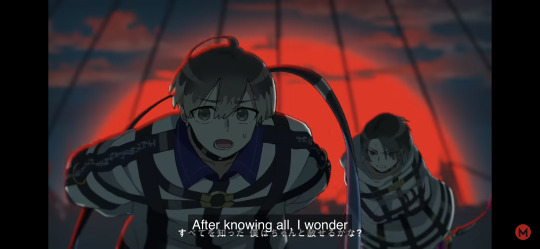
You can see that the lyrics overlaid on the prisoners in the first and second choruses match, but that may just be luck on my part. Or maybe it means something, I don't know anymore.
Something clearly happened between the first and second choruses. I think that the first chorus images were the prisoners' reactions to being dropped into Milgram, but what caused their second chorus expressions? Is this supposed to be their reactions to being moved out of Milgram? Something is clearly happening, and they are restrained. Kazui looks like he is avoiding a hit while Kotoko is rearing up to charge full-steam ahead. They're both the heavy hitters of the ten prisoners. Amane, the youngest, smallest, and weakest prisoner, is stumbling backwards like she was hit or she was scared enough to try and retreat from harm's way. The remaining prisoners look scared and/or worried. What exactly is going on here? Is something happening to them? Or to Es? Mikoto (must be Bokuto) and Mahiru are leaning over like they are checking up on someone. Are they escaping? Do we get an escape musical number to conclude the series? How baller would that be?
Very, but in all seriousness, something is up. There's just something about "Undercover" that is making me pause. This very well could all be useless speculation, and "Undercover" is canon in the way that the timeline conversations are canon without actually aging the characters.
TL;DR: Milgram is sus, and come the conclusion of this series, I have a <2% chance of being vindicated.
212 notes
·
View notes
Text
Es freaking out
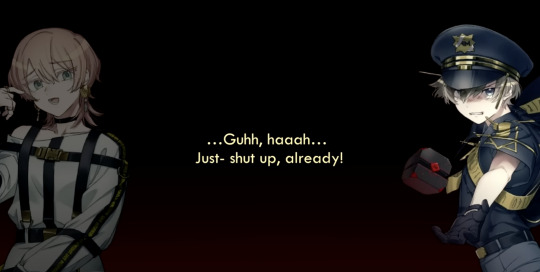
MILGRAM - Muu's Second Voice Drama (Queen B)
(16:02-16:30)
Some thoughts...
This is very interesting to me (and worrying, for Es’ sake). This isn’t the first time we’ve seen Es freak out at the end of, or during, an interrogation. The last time I remember was at the end of Kotoko’s first interrogation, where Es cried. I also believe something similar happened in Fuuta’s first interrogation?
I feel like Es’ lack of memory is intentional, perhaps Es was brainwashed by Milgram to preform this role? It’s not too wild of an idea, seeing how they can convert memories to songs and images, the guilty prisoners hear voices judging them (likely us), there’s an invisible force that stops the prisoners (except Mikoto) from attacking Es.
I feel like in these moments Es’ memories are trying to come up, and they in turn feel conflicted, confused, and sick. Clearly something is being repressed in their memory, at least that’s how I see it.
I am genuinely very worried for Es!!
Another thing I thought I’d mention was that in Fuuta’s second interrogation, Es becomes very understanding to Fuuta. They say they are starting to see them all as “comrades” and that they almost “regret” their decision. It was very touching. But, as soon as the bell rings Es completely turns around and doesn’t give a shit about Fuuta or any of the prisoners.
I wonder if when Es is showing kindness, that we are seeing “True Es.” But when Es switches over after the bell, we’re seeing “Prison Guard Es,” who I wouldn’t doubt is being manipulated by Milgram in some, or many ways.
65 notes
·
View notes

